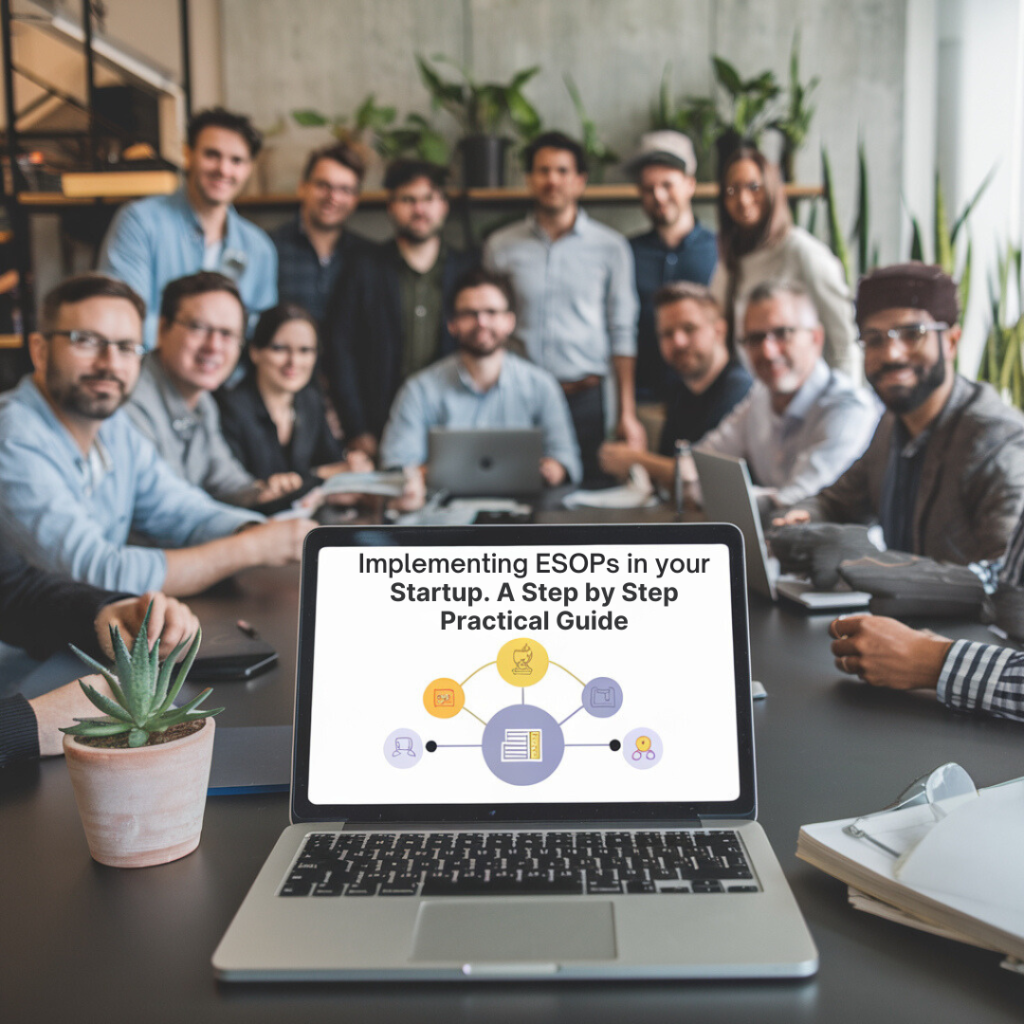You’re in a team meeting, reviewing the latest goals, but something feels off. While a few team members are fired up and engaged, others seem checked out—scrolling on their phones or mentally elsewhere.
You can’t help but think, “How can I get everyone on the same page, as invested in this company as I am?”
As a founder, you know that having a talented team isn’t enough. What really drives a startup’s success is the collective passion and commitment of everyone involved. But how do you create that sense of ownership? That’s where an Employee Stock Option Plan (ESOP) comes in.
A well-structured ESOP isn’t just about offering stock options—it’s about aligning your team’s goals with the long-term success of your company. With an ESOP, you give your employees a real stake in the outcome, turning that scattered energy into a shared mission.
Understanding the Importance of ESOPs
An effective ESOP promotes loyalty, boosts productivity, and attracts the best minds. It imbues workers with a tangible stake in the outcomes of the company’s success, compelling them to work harder and smarter. But it takes more than a few strategic moves to set one up. From determining the pool to deciding the eligibility to structuring vesting periods, every decision counts..
Here’s a practical guide to help you establish an ESOP that empowers your employees and drives business performance forward.
- Determining the right time for your ESOPs
Is now the right time to introduce an ESOP, or should you wait until your team grows? Choosing the ideal moment is essential, as it impacts both team morale and long-term alignment. Once you’ve settled on the timing, you can move forward with designing an ESOP that aligns with your team size and company goals.
Generally, having an ESOP in place for the very second employee does not work. But you may be an exception. Because this may be a case when right after the second employee, in a month’s time, you are going to be hiring 20 more. Well then you might as well have it in place early on.
The right time is generally when the company is on an upward track, and the employees can see their options increasing in value.
- Design an ESOP Scheme
Your first step is to draft a comprehensive ESOP plan with legal assistance. Here are critical components to consider:
- Eligibility Criteria Only permanent employees of the company are eligible to participate in the ESOP. This includes full-time employees and directors while excluding promoters or individuals holding significant equity stakes (greater than 10%). This ensures that the benefits of the ESOP are reserved for those committed to the long-term success of the organisation.
- ESOP Pool Size: Start with 5-10% of your total equity for the ESOP pool. Modify this percentage as your hiring needs evolve. Be aware—you don’t want too large a pool because that can dilute ownership for existing shareholders or too small, because you won’t be able to get the best talent.
- Cliff Period: In India it is highly recommended to have a minimum of 12 months cliff period. It is the time when an employee needs to be on board before his first options vest. This Cliff period will ensure that only committed employees will benefit from the plan.
- Vesting Period: Vesting period is usually around 2-3 years for most cases. That is, the employees earn their stock options within that period in order to make them work longer for the company. Some startups opt for shorter periods to attract talent quickly, but be cautious—longer vesting can deter employees who might feel locked in, while shorter periods may lead them to leave once fully vested.
- Monthly Vesting: A monthly vesting schedule is recommended as it keeps employees engaged and tied to the company over time. This will make it possible for the employees to constantly track their progress and give them a sense of ownership.
- Milestone Vesting: Besides the standard vesting, the ESOP may have milestone vesting provisions. This generally means that specific options will be permissible as and when specific performance metrics or firm milestones, such as revenue targets or product launches, are met.
- Exercise Period Employees can exercise their vested stock options within a defined exercise period, typically ranging from 3 to 10 years following the vesting period. This time frame provides flexibility for employees to purchase shares at the predetermined exercise price.
- Apply for a Valuation Certificate
You may need a valuation certificate to determine the strike price for your options. This certificate provides an estimate of your company’s fair market value and should be obtained from a qualified professional. Ensure this valuation is recent (within six months) unless significant events like funding rounds have occurred.
The strike price is crucial because it determines how much employees will pay for their shares when they exercise their options. Setting this price too high can discourage participation, while setting it too low may lead to tax implications later on.
- Get Board Approval
Once you work up your plan, get formal approval from the board of directors. You do not want to delay this for fear of causing friction with investors over-strike prices and market value. It’s essential to have board backing before moving forward with any ESOP implementation.
The board’s procedure of approval surrounds the briefing to the boards about the ESOP scheme, its merits for retention and motivation of workers, and the grievances of the board members about dilution or monetary consequences.
- Seek Shareholders’ Approval
After obtaining board approval, you need consent from shareholders through a special resolution during an Extraordinary General Meeting (EGM). This requires at least 21 days’ notice and an explanatory statement outlining the meeting’s purpose.
At EGM, the company will obtain consent from shareholders to create an ESOP pool. It’s crucial to communicate clearly about how the ESOP will benefit both employees and shareholders alike. The Notice to be issued to all the shareholders for the ensuing General Meeting will have the explanatory statement providing details to the ESOP plan and the reasons behind the company creating an ESOP Pool.
Once approved, register the resolutions with the Registrar of Companies (RoC) within 30 days by filing the necessary forms. Though it is additional documentation, it will be a foundation for the successful beginning of a startup in terms of meeting all the legal formalities.
- Start Awarding Shares
Now comes the exciting part: awarding ESOPs! Use grant letters to clearly outline terms such as vesting schedules and conditions. Be clear and enthusiastic—this is your opportunity to communicate the value of ownership to your team effectively.
Consider hosting an informational session where you explain how the ESOPs work, their benefits, and how employees can maximise their participation in it. This transparency helps build trust and excitement around the program.
- Ongoing Administration
Once your ESOP is established and shares are allocated, ongoing administration becomes essential for its success:
- Regular Communication: Keep employees informed about their stock options’ status and any changes in company valuation or policies related to the ESOP.
- Annual Reporting: Provide annual statements detailing each employee’s vested and unvested shares, along with updates on company performance and valuation changes.
- Monitor Dilution: Regularly review your ESOP pool size and its impact on existing shareholders’ equity. Avoid over-dilution by adjusting future grants based on funding rounds or changes in hiring needs.
- Exit Procedures: Establish clear procedures to address the handling of stock options when an employee departs the company. Define what occurs if an employee leaves before their options fully vest, including provisions for “good leavers” who retain vested options and may continue vesting under certain conditions versus “bad leavers” who forfeit both vested and unvested options. Additionally, outline the process for exercising options upon departure, ensuring transparency and fairness while protecting the company’s equity interests.
Conclusion
An ESOP is not difficult to establish. If you go through these steps, you will have an effortless process that shows your employees that you value their contributions to the journey of your startup. This is the most important component-the ownership culture. Through this, commitment among your team toward collective success will be inspired.
Looking to implement an ESOP and have questions about how to structure it effectively? Book a call with us using this link for FREE guidance on this.


